Bring Your Vet to the Cat: the Whole House Exam
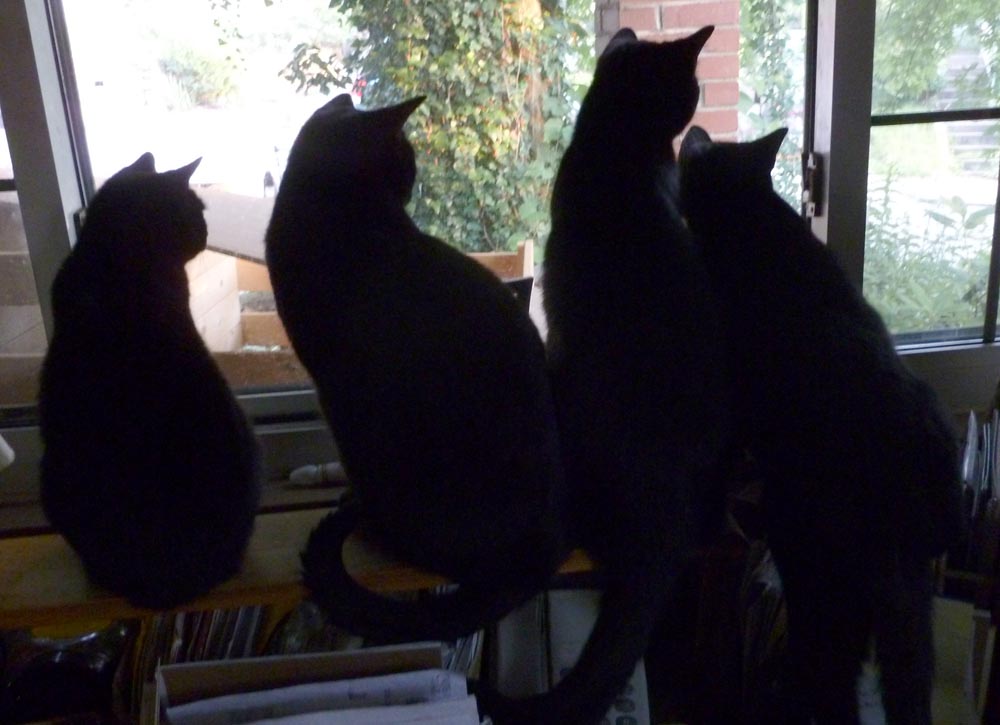
My regular veterinarian is a house call veterinarian, so when it comes to vet visits for seven cats, we stay home. I remember the days of driving with as many carriers as I could fit in my compact car with the Unhappy Meow Choir singing in the back seat, and trying to remember everything I wanted to say and ask about when I got there, really rattled by all that frightened and angry energy in the car.
Now all I need to do is clean off the table and kitchen island and turn on the light. The visit and exam don’t cost any more than most veterinarians, and I would want this veterinarian to treat my cats even if she wasn’t a house call veterinarian.
I have had years of geriatric cats, unpredictable illnesses and intensive treatments, but now my household is fairly stable with my two senior, technically geriatric, girls Cookie and Kelly at 19 and 17, and Mimi, about 7, and the Fantastic Four at four years old. And I can finally get back on the schedule of everyone’s appointments at the same time so I can keep track of everyone again.
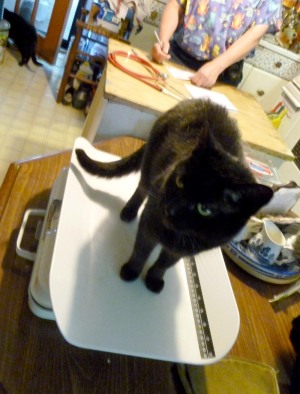
Seven angry cats?
My cats are all very social, so I knew no one would hide when my veterinarian and her technician arrived with all their strange and smelly stuff, invading our kitchen table, and true to form they all came in to observe, explore, ask for affection and generally get in the way, and all but Kelly hung around after the exam to watch what happened to everyone else. In between exams certain predictable kitties tried to get some affection, but those silly humans seemed to be preoccupied with something else and paid no attention no matter how hard kitties tried. Well, there was always the big black bag to go and root around in.
Their persistence meant all through the exams that getting the next kitty in line for an exam up onto the scale was easy since all were right there, except that Mimi decided she owned the scale that day and would not be removed except by force. This meant I picked her up and held her, squirming, while another kitty was weighed, then I set her on the floor and as if she had springs in her feet she was back up on the table and on the scale before I was fully upright again. And the kitty on the scale wanted to be petted so they kept moving around trying to get under someone’s hand for pets, so weighing took a little extra time.
The procedure
After finally getting a weight, everyone got nearly the same exam as my veterinarian followed the same procedure I’ve watched her follow for years.
As I set the kitty in question in front of her we discuss any prior conditions or current symptoms. She calms the kitty with pets, gently pulling it against her. The exam begins with the face, looking into the kitty’s eyes and ears, feeling along the contours and under the chin and jaw, then opens their mouth and looks inside, possibly giving one or another tooth a little wiggle.
|
|
|
|
|
|
Then she runs her hand down the kitty’s back and sides feeling for any abnormalities or tender spots, and around under the kitty’s belly to palpate its abdomen and examine its major organs. It’s always amazed me that she is building her own 3-D image of my kitty as her hands explore.
|
|
|
By this time a kitty’s usually elevated heartbeat and respiration are slowing down from the initial part of the exam. Next comes the stethoscope and the wristwatch and we all keep quiet while she listens to the functions of the heart and lungs and gets a heart and respiration rate. Temperature is taken only if needed.
All this is done before anything more invasive is done like vaccinations, or investigating any problem areas, “So we don’t blow the good mood,” my veterinarian says.

A nail trim is done if needed, and though I trim my kids pretty regularly or I’d be shredded by their affections Cookie managed to slip through. Her technician is there to help calm and confine the cat, to write notes in the records and get everything from tissues to vaccinations while the doctor’s hands are occupied.
Then, if there is nothing that needs another look, discussion, or treatment, kitty gets whatever shots are due and then is left free to go back to being a kitty.
I stay with the annual rabies vaccine (my vet doesn’t carry the three-year to limit the medications she needs to keep on hand), and only get the first rounds of FVCRP vaccines with kittens or cats who have just entered the house, but not annually after that. My geriatric kitties, past the age of 17 or 18, or if they have any major health problems, don’t continue with the rabies after that age.
This time we spent a little extra time on Cookie, which Cookie didn’t care for but dispensed nothing more than wicked looks at everyone. We were sore afraid, but the exam continued.
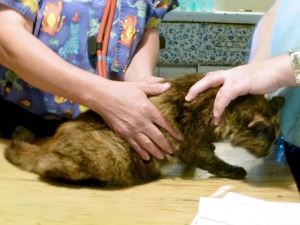
Cookie’s thyroid has been “thinking about hyperthyroid disease”for several years as my veterinarian has put it, levels are normal but her thyroid is slightly enlarged. This time it was definitely over the normal size with a physical exam, and I had recognized the symptoms in Cookie having seen it before in others, as if the kitty is speeding up a little bit: increased appetite, thirst, vocalization, activity, some weight loss, and an elevated heart rate. Sometimes you’ll notice coughing or vomiting, and I had heard Cookie coughing now and then. This time, apparently, Cookie’s thyroid had decided it was time to overachieve and because a treatment like RadioCat is out of the question for a cat of Cookie’s age and physical status, we discussed medication dosages for methimazole, or Tapazole. We would begin with ¼ tablet and I would take Cookie’s heart rate every few days and observe symptoms and report back.
We also noticed that Cookie was a little dehydrated, which could have been the hyperthyroidism or the beginnings of chronic renal failure, or both in tandem taking a toll on her kidneys and other organs. We’ve been watching for this change in Cookie as well, in part because it’s common in older cats and often difficult to diagnose until it’s quite advanced. She also had a little fluid in her belly which could have been caused by her reduced heart function or something else entirely, even a symptom of FIP, remembering when Lucy had been in the household or even another cause.

And lastly, Cookie had lost both some weight and some muscle mass in her hind legs and hips. She’s always had a little trouble walking, climbing, running and jumping, but now has a definite sway to her gait. She has no sign of arthritis, but this could be related to any of the conditions named above or simply loss of muscle mass at her age. I’m watching for increasing difficulty to see if we can diagnose from that what the cause is or if it’s a symptom of another condition, such as renal failure.
We finally put Cookie on the floor and she hurried to the back door and stood and looked at us, as if we’d let her out. Her gait was pretty normal, her attitude was totally normal.
This all sounds frightening about Cookie, but we’ve seen these conditions before and they are not unusual in a geriatric cat, though Cookie will need constant observation. Cookie was abandoned as a kitten and we’ve always watched for symptoms related to her early condition. She’s 19 and just beginning to show some wear and tear! I think that’s pretty good. My veterinarian again patiently explained all the possibilities and other symptoms to observe. Since Cookie is otherwise feeling just fine we decided to proceed with the methimazole and keep track of any changes.

When the last kitty was done the three of us were petting cats with both hands as five black cats and one little tortie milled about on the table eager to put us humans to good use, discussing Cookie’s symptoms and a few things about Kelly and the rest of the household.
I asked them if other feline households also hung around to watch the show so they could take breaks between exams and pet the other kitties. They said they typically watched their backs to make sure the other kitties weren’t planning an attack after the exam. I just love my guys!
And it was refreshing for the first time in a very long time for my veterinarian and her assistant to visit when there wasn’t an active illness or health crisis, just a nice, regular old group exam.
A little about my veterinarian
I am lucky to have a house-call veterinarian in my area, and not just because of the convenience of her house calls, but also because of her skills as a veterinarian and the way she manages her practice.
Some people are hands-off with treating their pets and some are hands-on, some people will tell you upfront they are not very observant and others find every detail. Your veterinarian’s relationship with you is as important as their relationship with your pet, and they need to be able to work with you at your level as well. I’m a hands-on person with most of what I do and it’s part of my nature to notice details.
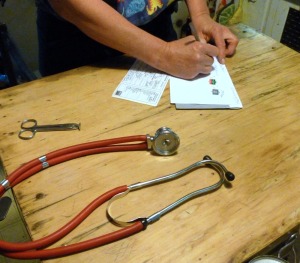
What does a veterinarian look for and what do they find when they look at your pet, do they think outside the realm of the typical, are they patient with your (hopefully reasonable) lists of possible symptoms, and how well do they explain what they find? They are the expert, and you, who spend your days with the animal and know it best, are the front line of its care with your observations, but you need to give your vet a chance to get to know your pet through regular exams, not just consulting in emergencies and health crises.
And how well does their practice serve your needs with your pets—I know that my needs with a variable house of regulars and rescues, kittens to geriatracs, is very different from the needs of a household with one or two pets. My crowd means lots of phone calls outside of regular visits, services that a house call veterinarian can’t perform like x-rays and surgery which means referrals or transferring records back and forth, and simply a good bit of intensive care by me at times which requires instruction and support so I need a lot of availability.
I’ve been using calling torturing working with the same veterinarian for about 18 years, as far as we can figure, and it’s not been just the convenience of her coming to my home, but her skills and practices keeping my household healthy by her combination of treatment, instruction to me, and referral when necessary. She has seen us through cancers, FIP, heart disease, chronic renal failure, chronic cystitis, geriatric conditions, a few things neither she nor anyone else ever figured out, and nearly a dozen euthanasias. And I’m not done yet.
In the meantime I have learned to take temperatures, give various injections, administer sub-cutaneous fluids, count heart rates and respiration, recognize and understand the symptoms of all the conditions listed above and then some, and the effects and side effects of a list of medications. And I’m sure she’s not done teaching me yet, either.
So we passed our exams this time!

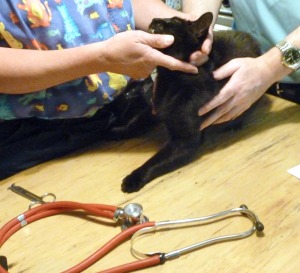
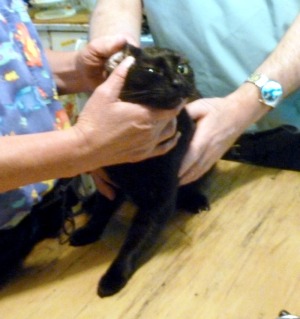



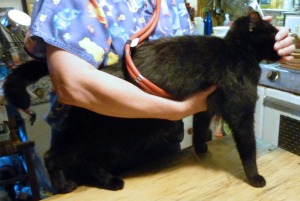

Pingback: The Creative Cat - Daily Photo: Annual Exams
Pingback: The Creative Cat - Loving Care for Your Senior Cat, Part 1
Pingback: The Creative Cat - Cookie Love, and Making Memories
Pingback: Living Green With Pets: Put Bird Feeders Out Now for Migrants « The Creative Cat
Pingback: Cookie Love « The Creative Cat
I have a vet/friend who I am trying to persuade to become a concierge vet. Hopefully she will read this story and consider it. 🙂
Juliet, that’s interesting–I have a graphic design customer who is a human doctor who opened a concierge practice. He actually has an office but will also make house calls; patients pay an annual retainer for his services.
I keep telling my veterinarian she should write about her experiences because she’s done an amazing job from her very beginnings when there were no other house call vets around. I think I’ll make appointments with her to interview and write parts of the story!
Wonderful post. Having a great vet who’s also a housecall vet is truly the best of both worlds for cats.
She has been the key to my household’s longevity and my education. I’ve had a lot of cats and it’s truly amazing how she remembers their conditions and histories, and then also deals with my often chaotic house!
Absolutely loved your post. Great to see you have a great rapport with your vet! Loved all the pics and information. Adorable kitty cats, they must have felt like they were invaded…hehehe
Thanks, Dr. Rayya! I’m so glad for my vet. I just read your post about the kitties too and I was just about to share that on Undercover Kitty and my FB page. I enjoy reading your rapport with your patients.